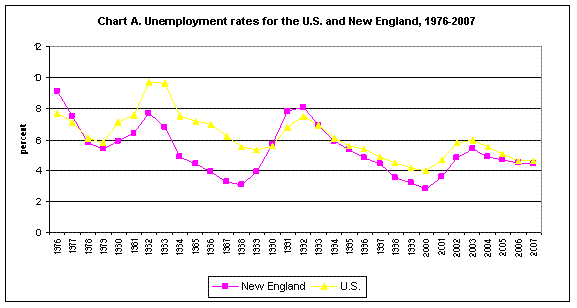|
USDL-08-126 For Release: April 28, 2008 For information: (617) 565-2327 Media information: (617) 565-2331 NEW ENGLAND ANNUAL UNEMPLOYMENT RATE HOLDS STEADY IN 2007 The annual average unemployment rate in New England, at 4.4 percent in 2007, was essentially the same as in the previous year, according to the U.S. Department of Labor's Bureau of Labor Statistics. The U.S. jobless rate was unchanged at 4.6 percent for 2007. (See table 1.) Regional Commissioner Denis M. McSweeney noted that New England's unemployment rate was little different from the national average in 2007 and has rarely exceeded the U.S. rate in the 32 years that these data have been collected. (See chart A.)
New England is one of nine geographic divisions in the United States. Jobless rates in the divisions ranged from 3.6 percent in the Mountain to 5.5 percent in the East North Central in 2007. Only two divisions, New England and the East South Central (4.8 percent) had unemployment rates that were not significantly different from the national average. Five divisions recorded annual average unemployment rates that were significantly lower than that for the nation-the Mountain, 3.6 percent; South Atlantic, 4.2 percent; West North Central, 4.3 percent; and Middle Atlantic and West South Central, 4.4 percent each. The East North Central and Pacific divisions reported rates that were appreciably higher than the U.S. average, 5.5 and 5.2 percent, respectively. (See table 2.) Along with New England, five other geographic divisions in the nation posted rates that were not appreciably different from those of the prior year. Of the three remaining, the West South Central and Mountain divisions registered significant rate decreases (-0.4 and -0.3 percentage point, respectively) and the Pacific division had a significant rate increase (+0.3 percentage point). Of the six states that make up New England, four had rates that were not appreciably different from the U.S. average-Rhode Island (5.0 percent), Maine (4.7 percent), Connecticut (4.6 percent), and Massachusetts (4.5 percent). The other two states-New Hampshire (3.6 percent) and Vermont (3.9 percent)-had had unemployment rates significantly lower than that for the nation in 2007. (See table 1.) Nationwide, Hawaii reported the lowest unemployment rate among the states, 2.6 percent in 2007, followed closely by Idaho and Utah, at 2.7 percent each. The states with the highest unemployment rates in 2007 were Michigan (7.2 percent), Mississippi (6.3 percent), and Alaska (6.2 percent). No New England state posted a statistically significant jobless rate change over the year. However, at the national level, 10 states recorded appreciable changes in their annual average unemployment rates from 2006 to 2007 with 5 registering rate decreases and 5, rate increases. New Mexico and Texas posted the largest over-the-year jobless rate declines (-0.8 and -0.6 percentage point, respectively), while Florida, Minnesota, and Nevada reported the largest rate increases (+0.6 percentage point each).
Technical Note This release presents labor force and unemployment data from the Current Population Survey (CPS) and the Local Area Unemployment Statistics (LAUS) program. Estimates for the U.S. are obtained directly from the CPS, which is a monthly sample survey of approximately 60,000 households nationwide that is conducted for the Bureau of Labor Statistics (BLS) by the Census Bureau. All subnational estimates presented in this release were derived from updated time-series models with monthly benchmarking to national Current Population Survey (CPS) estimates. Subnational data reflect revised population controls and model reestimation. Historical data were revised back to 2003. Data for regions, divisions, states, and the District of Columbia are available back to 1976. The LAUS program produces data for the nine geographic divisions in the United States: New England, Middle Atlantic, South Atlantic, East South Central, West South Central, East North Central, West North Central, Mountain, and Pacific. Data for all divisions, as well as the 50 states, are available in the Regional and State Unemployment release (http://www.bls.gov/lau/#news). Analysis in this news release reflects the use of model-based error measures when making comparisons with the U.S. and the prior year. BLS uses a 90-percent confidence level in determining whether changes or differences in subnational unemployment rates are statistically significant. Model-based error measures are available on the BLS Web site at http://www.bls.gov/lau/lastderr.htm. This information will be made available to sensory impaired individuals upon request. Voice phone: (617) 565-2072, Federal Relay Services: 1-800-877-8339.
Last Modified Date: April 30, 2008
Quick Links
| |||||||


